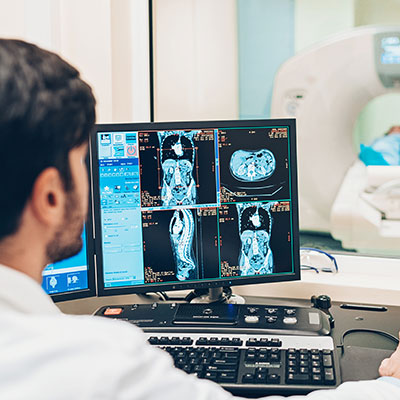Quantum physics and the advancement of imaging in healthcare
Published: 23 May 2022
Read more

Healthcare relies heavily on imaging, from X-Rays and MRI scans, to cancer screening and endoscopy, it is central to the diagnosis and treatment of disease. Because of this, scientists across the world continue to improve existing medical imaging technology and develop new solutions to make medical imaging technology faster, more effective, cheaper and accessible.
Quantum imaging is an emerging approach proving vital to achieving society’s healthcare needs of tomorrow. At QuantIC, the UK Hub in Quantum Enhanced Imaging, researchers are working together with industry to deliver biological imaging technology using new quantum-inspired effects. The research has shown promising capabilities while simultaneously reducing device costs and rapidly improving accessibility for patients.
Learning from COVID-19
Pulse oximeters are among the most common optical devices for monitoring blood oxygenation and they played a critical role during the COVID-19 pandemic. Pulse oximeters work by measuring the transmission of light through the patient’s fingertips and requires calibration based on skin tone and finger anatomy. However, this calibration is not suitable for everyone and often provides less accurate results in patients with darker skin tones or smaller than average fingertips.
QuantIC researchers, in partnership with semiconductor manufacturer Elmos, are working to develop an oximeter that provides accurate results no matter the skin tone or anatomy size. In turn delivering better healthcare services for all. The proposed device works on the travel time of light as well as its transmission, and measurements are made possible due to the extremely sensitive quantum detectors. The introduction an additional travel time measurement removes any patient calibration.
Quantum microscopy
Microscopy plays a central role in all disease diagnosis. Classical microscopes shine bright lights onto samples to allow researchers to see in great detail. However, this approach has its limits. In healthcare and biomedical fields bright light sources can destroy delicate samples, such as living cell, before a clear image can be made.
Quantum microscopy is exploring several different ways of solving this challenge. One approach is to illuminate the delicate sample with very low intensities of a safe wavelength and then use quantum correlations to transfer this image to light that brighter and/or at a different wavelength that is therefore easier to detect. Another is to use quantum optical effects to produce laser-light displaying ultra-low noise levels, below what is classically possible, alongside next generation single-photon detectors capable of imaging in low levels of light.
Quantum imaging is enabling dramatic improvements in microscopy and the 3D imaging of the most fragile and delicate biological samples, allowing for more detailed and precise diagnosis of disease.
Possibilities for non-invasive imaging
A new imaging technique, allowing 3D imaging at video rates through a fibre the width of a human hair, could transform imaging for a wide range of applications in industrial inspection and environmental monitoring. But in the longer term this technique could be further developed for applications in medical imaging such as endoscopy, surgery, and non-invasive screening.
“In applications like endoscopy imaging is traditionally achieved by using a bundle of optical fibres, one fibre for every pixel in the image, resulting in devices the thickness of a finger.
“As an alternative, we are developing a new technique for imaging through a single fibre the width of a human hair. Our ambition is to create a new generation of single-fibre imaging devices that can produce 3D images of remote scenes” said Professor Miles Padgett, QuantIC Principal Investigator.
Replacing MRI and X-Ray
Imaging through the human body with visible light is another goal for QuantIC’s leading research teams. They want to use quantum light-in-flight techniques, which makes imaging through tissue possible, to replace expensive and limited MRI and X-Ray machines with hand-held portable devices. The pioneering team are due to present their exciting first results later in the year.
The use of quantum science in medical imaging could revolutionise medical diagnosis and improve treatment for all. To find out about other technologies in this field and how you can work with QuantIC contact Christopher.Payne-Dwyer@glasgow.ac.uk
First published: 23 May 2022

